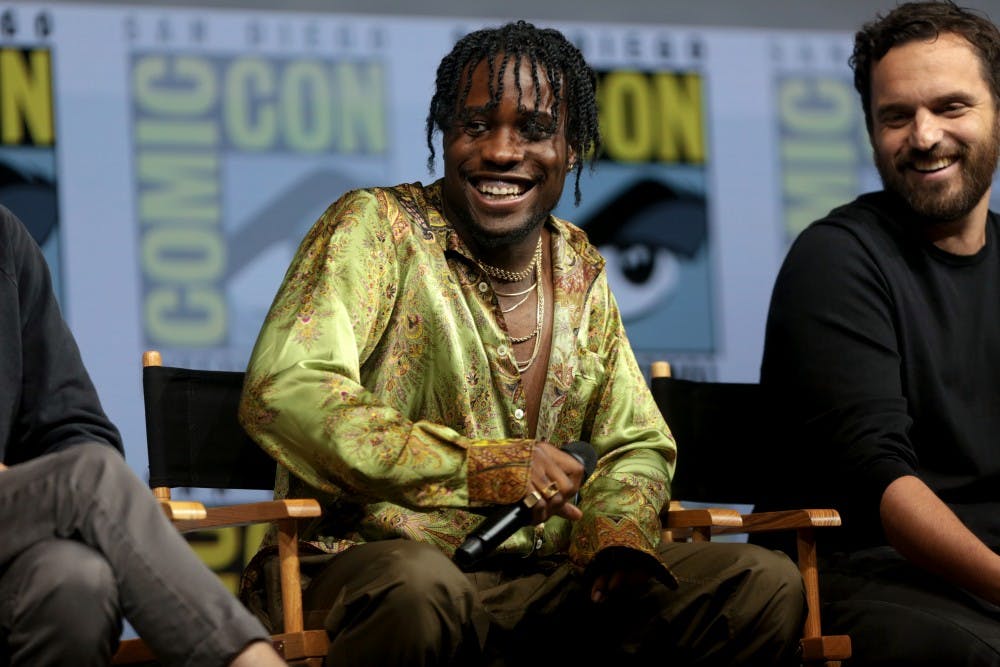After years of putting out cookie-cutter superhero movies, Marvel finally brings its audience something new with their latest animated hit, Spider-Man: Into the Spider-Verse. Despite making yet another Spider-Man movie, the writers of Into the Spider-Verse somehow deliver a superhero movie unlike any other.
With each new movie, the Marvel franchise feels more and more disconnected from the original comics. While certainly still enjoyable, the movies seem to only sustain the characters and general storyline from the comics. Into the Spider-Verse, however, seems to revive those long lost ties. From the animation style, fun nature and classic superhero narrative, you can see the roots of a comic book shine through in ways the screen has not yet seen.
This latest take on Spider-Man tells the story of Brooklyn resident, Miles Morales (Shameik Moore), a free-thinking rebellious teenager who would rather be on the streets throwing up art with his uncle than stuck in class at his new elite school. Miles lives in a universe that is similar but not identical to our own. There they have Koca-Soda instead of Coca-Cola, the Red Man Group instead of the Blue Man Group, and most importantly, as Miles discovers, two Spider-Men instead of one.
But that’s just the start. Miles learns that many Spider-People have been sent to his dimension by accident. There is Gwen Stacy (Hailee Steinfeld), the graceful rocker-chick who has sworn herself to solitude; Peter Porker (John Mulaney), the spider pig from the old Marvel comic Spider-Ham; Spider-Man Noir (Nicholas Cage), the monochrome Mr. Parker from the 1930s; Peni Parker (Kimiko Glenn), the anime girl psychically linked with a radioactive spider piloting a crime-fighting robot; and of course our universe’s Peter Parker (Jake Johnson), not the crime fighting teen we know and love but the mid-30s, pizza-eating, sweatpant-wearing, futon-living, divorce-coping shadow of the once adored hero.
Miles, who is only just beginning to control his spider powers, embarks on an adventure to return the Spider-People to their universes and stop the forces that brought them there in the first place.
In all honesty there is nothing particularly surprising about the storyline. The writers give you what you expect: an underdog protagonist, a handful of supporting heroes and some bad guys to take down. This wholesome family movie ticks all the boxes: humour, heart and the touching takeaway that anyone can wear the spider mask (given they are bitten with a radioactive spider). Yet even with a relatively simple story, Spider-Man: Into the Spider-Verse still blows us away.
This is largely due to the absolutely stunning animation and design of the movie. Unlike anything seen before, Into the Spider-Verse takes place in a world previously reserved for the pages of a comic book. The animation style perfectly integrates signature elements of a comic book onto the big screen. Just like the graffiti Miles loves to design, everything in this movie pops, not only the vivid colors of the action sequences but also the very movements of the characters have been animated to make them look sharp and almost jolted. In many ways the thought bubbles, comic panel action sequences and onomatopoeia call outs could easily become cliche and overdone, but the animators integrate them in such a way that the world’s aesthetic and even the story itself would be incomplete without them. From the way the dimensions come colliding together in a colorful glitching catastrophe, to the vibrant illustrations of how the spider sense alerts Miles to danger, the animators appear to have fully harnessed the new style of animation they invented. One of the most visually outstanding scenes from this comic-movie is when Miles’ senses are overwhelmed the morning after being bitten. His loud thoughts overpower him and the screen in such a way that the audience can experience the disorientation of a newly acquired spider sense.
The animators also make this movie especially unique in how they maintain the different animation styles of the other Spider-People. Each Spider-Person stays true to their universe’s style, no matter how out of place they seem in Miles’ world; Peter Porker stays a comically overdone character full of bad jokes and anvil-dropping attacks; Peni Parker remains a bubbly anime-style girl striking Sailor-Moon-like poses when introduced.
In addition to being visually stunning, the soundtrack is an all-hits album that fits perfectly with the tone and message of the movie. From Post Malone’s “Sunflower” to Aminé’s “Invincible,” this album is packed with stars and their assortment of rap and R&B. It is the perfect background for the adventure Miles embarks on.
Spider-Man: Into the Spider-Verse is above all else a fun movie. Not only will it have you laughing out loud, but there is also a sense of fun in exploring a part of the Marvel universe we have not seen yet, the multiverse. It is clear the creators had fun playing with this movie, from the writers borrowing Spider-People from across generations, to the animators experimenting with comic-book elements on the big screen. Moviegoers are left at the end of the movie craving more, not only to see what is in store for Miles and the multiverse but also to live just a little longer in the extraordinary world the animators have created.





